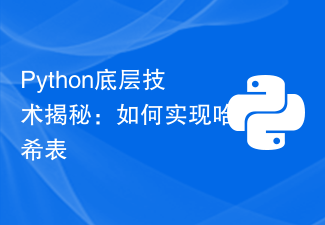
Reverse mapping in Aerospike is an important feature that allows developers to query and retrieve data from the data store. Reverse mapping maps the values of key-value pairs back to the corresponding keys by creating an index in the database. This capability helps developers query and analyze data more efficiently, improving application performance. In this article, we will detail the principles and usage of reverse mapping in Aerospike and how to use it in PHP. Whether you are a beginner or an experienced developer, this article will provide you with a comprehensive guide to reverse mapping to help you take advantage of the power of the Aerospike database.
Question content
I have some records in aerospike in the following key-value pairs:
Key : "1234"
Value : {
"XYZ":{
"B":[1,3]
"C":[3,4]
}
}
Key : "5678"
Value : {
"XYZ":{
"B":[1,3,5]
"C":[3,4]
}
}
I want to get all keys from the set where field "b" contains 3 in json value. Is there a way to query all such keys in golang?
Workaround
Yes, you can build a secondary index on the values in map key "B" at that nesting level...and then run a secondary index query to get all Matching records.
You can perform the same operation in Go using the equivalent API.
Many Java interactive code examples are located at: https://developer.aerospike.com/tutorials/java/cdt_indexing
For example, here is the top-level example with a string value:
Then another example where SI can be built on nested sublevels:
The above is the detailed content of Reverse mapping in Aerospike. For more information, please follow other related articles on the PHP Chinese website!
 修改文件扩展名为.INIFeb 18, 2024 am 10:36 AM
修改文件扩展名为.INIFeb 18, 2024 am 10:36 AM如何更改文件类型为ini随着计算机的普及和应用软件的多样化,我们经常会遇到需要更改文件类型的情况。其中,将文件类型更改为.ini文件是一种常见的操作。本文将介绍如何简单快捷地将文件类型更改为.ini。首先,我们需要明确.ini文件的特点和用途。.ini文件是一种用于存储配置信息的文本文件。它通常以.ini作为扩展名,并包含键值对的形式。通过修改.ini文件中
 当关系的一侧已存在于数据库中时,使用 SQLModel 插入多对多关系对象Feb 06, 2024 am 08:00 AM
当关系的一侧已存在于数据库中时,使用 SQLModel 插入多对多关系对象Feb 06, 2024 am 08:00 AM我正在尝试使用sqlmodel在数据库中插入记录,其中数据如下所示。一个house对象,它有颜色和许多位置。地点也将与许多房屋相关联。输入为:[{"color":"red","locations":[{"type":"country","name":"netherlands"},{"type":"municipality","name":"amsterdam"},
 在golang中获取JSON格式的x-www-form-urlencoded请求的嵌套键值对Feb 09, 2024 pm 03:15 PM
在golang中获取JSON格式的x-www-form-urlencoded请求的嵌套键值对Feb 09, 2024 pm 03:15 PM我有一个用例,我们在x-www-form-urlencoded主体中获取嵌套键值,如下所示name=abc&age=12¬es[key1]=value1¬es[key2]=value2我尝试了url.parsequery("name=abc&age=12¬es\[key1\]=value1¬es\[key2\]=value2")但它给出了{"name":"abc","age":12,"notes[key1]":"value1","note
 GO 中将 Map 转换为 List 的通用函数Feb 13, 2024 pm 08:30 PM
GO 中将 Map 转换为 List 的通用函数Feb 13, 2024 pm 08:30 PM如何在go中编写一个函数,将任何map转换为对象列表(删除键)?例如:funcmaptolist(inputmapmap[any]any)any{varresultlist[]anyfor_,obj:=rangeinputmap{resultlist=append(resultlist,obj)}returnresultlist}funcmain(){mymap:=make(ma
 php数组键值对是什么Aug 03, 2023 pm 02:20 PM
php数组键值对是什么Aug 03, 2023 pm 02:20 PMphp数组键值对是一种数据结构,由一个键和一个相应的值组成,键是数组元素的标识符,而值是与键相关联的数据。允许我们以键为标识来存储和访问数据,通过使用键值对,可以更方便地操作和管理数组中的元素,使得程序开发更加灵活和高效。
 在Java中使用枚举类型来赋值的方法Jan 31, 2024 pm 06:33 PM
在Java中使用枚举类型来赋值的方法Jan 31, 2024 pm 06:33 PM什么是枚举类型?枚举类型(enum)是Java编程语言中的一种特殊数据类型,用于表示一组预定义的常量。枚举类型中的每个常量都代表该类型的一个可能值。如何使用枚举类型设置值?要使用枚举类型设置值,可以使用枚举类型的常量。枚举类型的常量可以通过点运算符(.)访问。例如,如果有一个名为Color的枚举类型,其中包含三个常量:RED、GREEN和BLUE
 Python底层技术揭秘:如何实现哈希表Nov 08, 2023 am 11:53 AM
Python底层技术揭秘:如何实现哈希表Nov 08, 2023 am 11:53 AMPython底层技术揭秘:如何实现哈希表哈希表是在计算机领域中十分常见且重要的数据结构,它可以高效地存储和查找大量的键值对。在Python中,我们可以使用字典来使用哈希表,但是很少有人深入了解它的实现细节。本文将揭秘Python中哈希表的底层实现技术,并给出具体的代码示例。哈希表的核心思想是将键通过哈希函数映射到一个固定大小的数组中,而不是简单地按顺序存储。
 Redis键值对操作在Java开发中的应用:如何快速存取数据Aug 01, 2023 am 09:36 AM
Redis键值对操作在Java开发中的应用:如何快速存取数据Aug 01, 2023 am 09:36 AMRedis键值对操作在Java开发中的应用:如何快速存取数据在Java开发中,数据的存取操作是一项非常重要的任务。如何快速、高效地存取数据是开发者所关注的一个重点问题。而Redis作为一种高性能的内存数据库,具备快速读写操作的特点,因此在Java开发中被广泛应用于数据缓存和存储实现。Redis是一个支持键值对存取的内存数据库。它将数据存储在内存中,因此数据的


Hot AI Tools

Undresser.AI Undress
AI-powered app for creating realistic nude photos

AI Clothes Remover
Online AI tool for removing clothes from photos.

Undress AI Tool
Undress images for free

Clothoff.io
AI clothes remover

AI Hentai Generator
Generate AI Hentai for free.

Hot Article

Hot Tools

Dreamweaver Mac version
Visual web development tools

MinGW - Minimalist GNU for Windows
This project is in the process of being migrated to osdn.net/projects/mingw, you can continue to follow us there. MinGW: A native Windows port of the GNU Compiler Collection (GCC), freely distributable import libraries and header files for building native Windows applications; includes extensions to the MSVC runtime to support C99 functionality. All MinGW software can run on 64-bit Windows platforms.

MantisBT
Mantis is an easy-to-deploy web-based defect tracking tool designed to aid in product defect tracking. It requires PHP, MySQL and a web server. Check out our demo and hosting services.

Atom editor mac version download
The most popular open source editor

Notepad++7.3.1
Easy-to-use and free code editor







